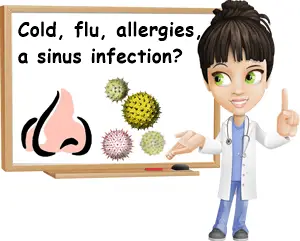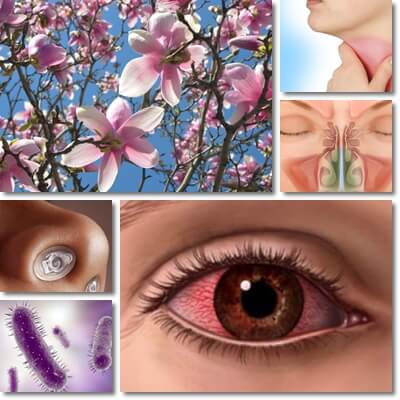Spring is the season when you can easily get everything from the common cold to the flu to allergies to sinus infections, sometimes more than one at the same time. But even if you would get them one at a time, it may seem impossible to tell the difference between them given they produce such similar symptoms. How can you tell if what you have is a cold or the flu or allergies or a sinus infection? Often times, it’s all about which symptoms are present and, just as important, which are not.
Is it a cold or the flu?
What is the difference between the common cold vs the flu? You can catch both a cold and the flu at the same time since the viruses causing them run from the start to the finish of the cold season, starting with chillier autumn days and ending with warmer spring days. However, it’s usually either a cold or the flu, not both at once, although having one may make you susceptible to getting the another. And while symptoms are different from person to person, most people find the flu is overall worse than the common cold and lasts a lot longer: the typical duration of a cold is 2-5/7 days, while the duration of the flu is 7-10/14 days (so double the time).

You can usually tell it’s the flu if you experience tiredness or fatigue and mild to severe pains and aches throughout the body, including generalized muscle, joint or bone-like pain. With a cold, it’s usually more of a runny nose preceded by lots of sneezing and maybe also a sore throat with hoarseness. A cold is more likely to allow you to be on your feet since it causes overall milder symptoms. Colds don’t typically cause a fever or, if they do, it isn’t usually too high or breaks relatively easily. In those that aren’t asymptomatic, the flu tends to cause high-grade fever that lasts for up to a few days and, at some point, you can’t find the strength to be up on your feet.
Is it allergies or a cold?
What is the difference between seasonal allergies vs the common cold? Allergies are extremely common, especially in springtime. With allergies you sneeze all the time, especially early in the morning when you wake up or if you go outside, particularly on a windy day. You’ll likely be sneezing for as long as the plant you’re allergic to is in bloom producing pollen. If there’s more than one, then there’ll be a lot of sneezing for weeks maybe. Not to mention the red, watery, itchy eyes, a symptom specific to allergic rhinitis. By comparison, sneezing occurs mostly in the beginning of a cold and tends to slowly let down as the infection progresses towards other symptoms.
Allergies also cause mucus to build up in the throat and nose and make you cough up phlegm or give you a runny nose all the time. The biggest sign it’s allergies you’re dealing with is the fact that the mucus is usually either transparent or white, sometimes with grey streaks from dust you may inhale, and does not change color. Find out more about what white mucus in nose and throat means.
Allergies don’t typically cause green mucus, or yellow for that matter. If it’s an infection like a cold, the mucus changes color from white to yellow or even green. The difference in color is a sign of the progression of the infection. Colors such as yellow or green may indicate the presence of white blood cells together with viruses that have been destroyed by the immune system.
The worse the allergies, the more excessive the mucus production and the lengthier the runny nose (may last for weeks). A cold on the other hand is shorter in duration, lasting 2-5/7 days, so there’s a limited time span for runny noses stuffed with mucus. The common cold causes a sore throat and sometimes irritated, inflamed nasal passages. You can usually tell if it’s allergies vs a cold if everything itches, starting with your throat (tingling throat sensation caused by allergens) and ending with your eyes, nose and ears. Allergies don’t give you chills and fever, but a cold will. They instead make you drowsy, causing you to want to sleep all the time or, in some people, cause insomnia, reducing sleep duration.

Is it a cold or a sinus infection?
What is the difference between the common cold and sinusitis? How can you tell the two apart? Well, a cold lasts up to a week, a week and a half tops. By the time it’s coming to an end, symptoms should have subsided almost completely. A sinus infection lasts longer and can derive from a cold (it can be viral in nature or occur as a sort of a bacterial infection secondary to the cold). Colds can cause headaches, but they are not always present. If it’s an infection of the sinuses, headaches, teeth aches and jaw aches are all common and ear infections are a possible side effect.
While there’s mucus production with a cold too, if it’s a sinus infection, the mucus tends to build up in the sinuses and cause puffiness, tenderness, pressure and even pain in the area (also known as sinus pain). Also, the pressure or pain is worse when you lean forward, tilt your head back or lie down on your back. Because of the mucus blocking the sinus passages and allowing for bacteria buildup, a sinus infection can cause bad breath too as well as a change in mucus color to yellow or even green. Find out more about what nose mucus color means.
It is the flu or a sinus infection?
What is the difference between the flu and a sinus infection? A sinus infection affects primarily the sinuses and most of the symptoms tend to focus on the middle part of the face, where the sinuses are. Actually, the most telling symptom to help you make the difference between the flu and a sinus infection is the fact that a the latter causes a feeling of fullness, tenderness, pressure or even pain in the middle of the face. The flu produces more general symptoms affecting most of the body, including often severe aches and pains, fatigue or even fainting.
Sneezing from the sinus inflammation, loss of smell and taste, bad breath and earaches are more common with sinus infections, whereas chest discomfort and coughing (often severe) occur more often with the flu. Coughing with a sinus infection is on-and-off and more likely an effect of postnasal drip, when mucus from the nose drips down the back of the throat (this can cause a tickling sensation which triggers coughing). Fever and congestion are overlapping symptoms. Both the flu and acute sinusitis can last for 2-4 weeks, but chronic sinusitis can easily last for 2-3 months.
Is it allergies or a sinus infection?
What is the difference between seasonal allergies and a sinus infection? Allergies cause inflammation of the sinuses, productive mucus and congestion and may lead up to an infection in some cases, including a sinus infection. But if you experience headaches and facial pain or tenderness that affects the cheekbones, area above the nose or upper jaw, then it’s likely a result of buildup of potentially infected mucus and can indicate a sinus infection. Just as important, allergies cause clear, white or, at most, mucus with some grey streaks from dust particles. Mucus produced during a sinus infection typically changes color as the infection progresses and may turn yellow or green.
Both sinusitis and allergic rhinitis can cause loss of smell and taste, but only sinusitis causes bad breath, jaw or ear pain. With allergies, everything itches – your eyes, ears, nose, gums, throat -, your eyes are watery and red, you sneeze all the time and are constantly filled with mucus making your nose runny. Fever is a symptom characteristic of a sinus infection. In addition to tenderness and pain in the middle of the face, congestion caused by a sinus infection leads to pressure that intensifies when you lean forwards, tilt your head back or lie on your back.
Is it allergies or the flu?
What is the difference between allergies and the flu? Since it’s an infection, the flu usually causes fever, high-grade and lasting for days; allergies don’t cause any fever, ever. With the flu, you develop a steady cough, often severe. If it’s allergies, coughing is intermittent and typically only occurs when you’re outside or have just come from spending time outside where you’ve had contact with pollen or other allergens. Coughing with allergies is preceded by a tingling sensation in the throat and usually a sign of a laryngospasm – the airways closing as a result of exposure to an allergen. Simply drinking some water should help inactivate or remove the allergen and stop the cough.
With the flu you don’t sneeze, at least not very often. With allergies, you sneeze a lot; sneezing helps remove pollen or other allergens you might have inhaled. Excessive nose and throat mucus is common with allergies, but the mucus is always either clear or white, sometimes with grey streaks if you’ve happened to have inhaled dust particles. With the flu, mucus turns yellow or green over the course of a few days. Allergies can’t produce yellow or green mucus. Changes in mucus color are indicative of the progression of an infection.
While congestion is common in both allergies and the flu, with allergies, the stuffy nose usually clears up once you’ve been inside for a while and have washed you face, hair and changed your clothes to inactivate or remove allergens such as pollen. You don’t get aches and pains if you have allergies – that’s the flu. But you are itchy all over – eyes, nose, mouth, throat, ears -, have red, watery eyes and may be tired and sleepy. Either this or your allergies may give you insomnia. After reading through, which of the four do you think you most likely have?
